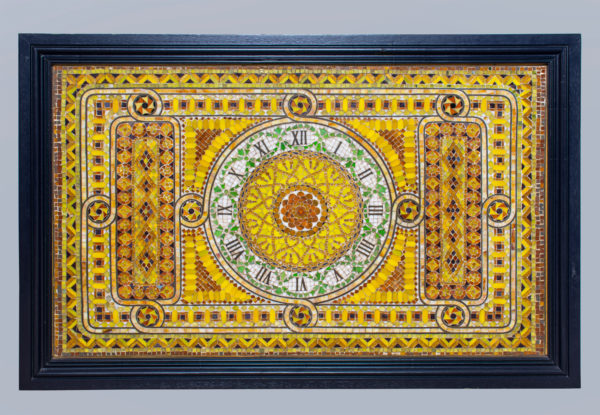Favrile Glass Mosaic Clock Face Panel, ca. 1905
Tiffany StudiosFavrile glass mosaic and bronze
Favrile Glass Mosaic
Grand in scale and complex in execution, this unique Tiffany Favrile Glass Mosaic panel showcases Tiffany Studios’ mastery of the medium of mosaic.
Prospective clients looking to commission Tiffany Studios could visit the Mosaic Showroom to see a selection of sample panels showing the possible options for borders, color schemes or design options. For certain projects, Tiffany’s artists created sample panels specifically produced for the client’s approval. The scale and complexity of this large flat panel indicate that it may have been a sample presented to a client for an architectural commission.
A round, classical clock face occupies the central space. Backed by matte white glass, the roman numerals – outlined in festoons of green garland – are formed by inset cast bronze pieces, a rare inclusion in a Tiffany Glass Mosaic. The thin dark framing lines throughout the panel are also bronze.
The white clock face is contrasted by the vibrant bright yellow opaque glass which forms the majority of the background of the panel. The center of the clock features a radiating circular motif articulated in both opaque and foil-backed transparent glass; the contrasting depths produces a pleasing visual effect, while the metallic backed golden glass shimmers. The scrolling motif which surrounds the central sunburst motif is formed by hand-cut glass tesserae of particularly small scale.
The design is related to two important extant examples of Tiffany mosaics; the first was Tiffany’s commission for the Chicago Public Library, now the Chicago Cultural Center, which features a mosaic clock surrounded by similar classical scrolling motifs. This panel is also related in design to the three Favrile Glass Mosaic clock medallions that were set into marble above the mantel piece in Louis Comfort Tiffany’s famed dining room at Laurelton Hall. There, the three clocks were illuminated from behind at night to dazzling effect – one marked the time of the day, one the day of the week, and one the date of the month. These clocks are on permanent display today at the Charles Hosmer Morse Museum of American Art in Winter Park, Florida, where the remaining elements of Laurelton Hall are preserved.
Literature
- Kelly A. Conway and Lindsy R. Parrott, Tiffany’s Glass Mosaics, p. 208 fig 6.28

